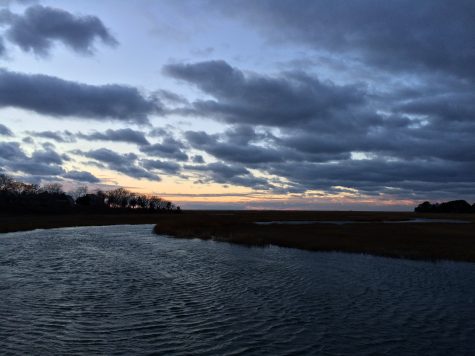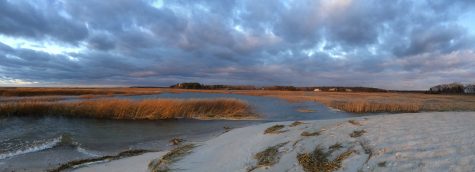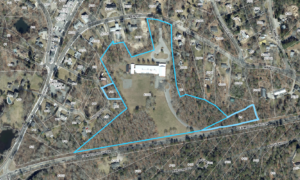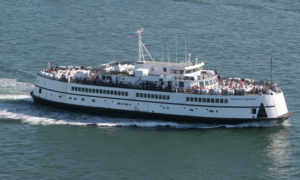The Cape Cod Canal has been helping vessels shorten their travel routes since its opening in 1914. It predated the Panama Canal by a few weeks which was later named one of the Seven Wonders of the Modern World in 1994 by the American Society of Civil Engineers. It has seen countless vessels pass through its roughly seven-mile length and is now a deeply rooted piece of the history of the peninsula.
However, did you know that the Cape Cod Canal was in fact not the first canal to have been created on the Cape?
That distinction belongs to a waterway located approximately twenty-six miles to the east in the towns of Eastham and Orleans. ‘Jeremiah’s Gutter’ was the name of this waterway. ‘Gutter’ is another word for a channel or waterway. The name ‘Jeremiah’ comes from Jeremiah Smith who came from a founding Eastham family of the late 17th century. The ‘gutter’s’ creation would come from a storm steeped in history for another reason.
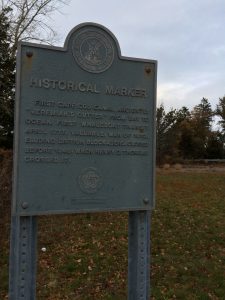
The historic marker designating where Jeremiah’s Gutter once passed by. It is located near the Wendy’s at the rotary in Orleans.
On April 26, 1717 a strong nor’easter battered Cape Cod. It was in this storm that the famed pirate ship Whydah sank with all of its treasure aboard. This storm also carved a channel of varying depths running roughly from Town Cove in Orleans west to what is today Boat Meadow Beach in Eastham. The channel would only be used by British vessels trying to recover the sunken Whydah treasure in 1717. Afterwards it began to close up due to nature and a bit by the locals. The marshlands surrounding the channel, which stretched across the Cape from bayside in Eastham to oceanside in Orleans, would often flood causing the channel to be resurrected in a shallow form over the next several decades.
In 1804 it was decided to widen and deepen the passageway out along the previously created channel which ran over a mile and a half, nearly congruent with the Eastham/Orleans town line. The canal would be named Jeremiah’s Gutter to honor Smith as it was much of his property that the waterway ran across.
Despite Jeremiah’s Gutter being newly widened and deepened it was barely used for nearly a decade. This changed during the War of 1812. It was during the second war with the British that the canal would be used as a passageway by American ships carrying salt to avoid England’s blockade of Provincetown. This would be the Gutter’s largest claim to fame.
Due to the large system of sandy tidal flats along Cape Cod Bay stretching from Brewster to Eastham the bayside entrance to the canal would often become choked with silt making that entrance way unreliable at low tide. It would again be sparsely used by traveling vessels and would not be maintained. Jeremiah’s Gutter fell into disrepair again and would cease to be used as a passageway for boats, although as late as 1844 large enough storms and tides would push water through making the canal whole again for a brief time.
Though it had begun fading into history the canal would have one more brush with fame when author Henry David Thoreau would mention Jeremiah’s Gutter in his iconic 1865 book Cape Cod. After that the eyes of the Cape would begin searching for a different location to create a more dependable canal. The idea of a new canal became more pressing during the late 1880’s when shipwrecks along Cape Cod’s coast occurred once every two weeks.
The location was chosen due to the proximity of two rivers flowing through a valley in Bourne, Sagamore, and Sandwich. The Manomet River would enter through Buzzards Bay at the western end, while the Scusset River entered through Cape Cod Bay at the eastern end. Once wealthy financier August Belmont II became involved in 1904 the Cape Cod Canal project became a reality. It would take a decade of work until it eventually opened in 1914. For the vast majority of people who cross this manmade waterway it is the only canal that has ever existed on Cape Cod.
It has been nearly two centuries since Jeremiah’s Gutter was last truly in use. In the time since it was discontinued it has reverted to its natural state. The opening at Boat Meadow Beach still remains and looks as though it could still be traveled at high tide. However the creek becomes more and more narrow heading toward Town Cove to the point where it virtually has vanished due to the construction of the Orleans Rotary. The Gutter is memorialized through a marker just off of the rotary with Jeremiah Smith’s home residing only a few hundred yards away on Old State Highway.
By Christopher Setterlund




